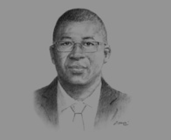OBG talks to Hien Yacouba Sié, Director-General, Port Autonome d’Abidjan

Interview: Hien Yacouba Sié
In what ways do current container flows demonstrate a need for a second container terminal?
HIEN YACOUBA SIÉ: Abidjan was the first port on the West African coast to build a container terminal in 1982, and because of this success story, many ports in the region have followed suit. There is no reason now that we should be the last to build a second one.
The terminal we have works well and in terms of capacity could eventually reach 1m to 1.2m twenty-foot equivalent units (TEUs) per year. However, projections have shown that it will be saturated by 2017. As such, we cannot allow for the port to be a bottleneck for container flows. Goods are increasingly transported by container, not only for Côte d’Ivoire but for the hinterland countries as well. There are mining projects in Mali, Burkina Faso and Niger, and input equipment for mining production travels by container.
As a result, the government issued a tender for a second terminal in May 2012, and a working partner was selected in March 2013. The new terminal will be able to handle 1.5m TEUs per year, bringing the port’s total container capacity to 3m. In choosing a partner, special attention was paid to trans-shipment capacity, as shippers choose where they unload. Although limited tax revenue will be generated by trans-shipment, such traffic will have a positive impact. Initially, we are expecting 300,000 TEUs of annual trans-shipment activity.
How long will the port’s infrastructure upgrade works take? How will space be made available?
SIÉ: The infrastructure for the docks at the second container terminal and works on the Vridi Canal will be paid for by the government and carried out by CHEC, while the terminal’s operator will be responsible for superstructures and equipment. After the signature on the terminal in August 2013, it will take three years to complete works on the Vridi Canal and the second terminal, and an additional year for the operator to install equipment on the terminal. Space for the new terminal will actually be created by backfilling 30 ha on the lagoon. Our partners have been chosen, and financing is currently being sought.
In a separate project, new industrial zones will be created by backfilling in the Biétry Bay, amounting to 30 ha in a first phase, and will eventually be expanded to around 200 ha. Demand for industrial zones is very high and supply very low, and this project can provide industry with more space for expansion. We have secured financing from the Banque Ouest Africaine de Développement and intend to issue a tender by the end of 2013 for backfilling in Biétry Bay. At the same time, we are preparing a build-operate-transfer dossier for additional backfilling, combined with the construction of a bridge, all of which will help unclog the port area.
What specific measures are in place at the port to discourage maritime piracy?
SIÉ: In June 2013, there was a summit in Yaoundé with the participation of 22 countries to address this problem. Piracy has been a growing threat to the safety of our coasts, and the countries have agreed to pool resources to acquire the expensive equipment required to combat piracy at sea. Beyond this, the EU is providing assistance on a training project for West African operators to be better informed in the fight against piracy. Furthermore, the government’s security agents are tackling this problem head on by considering ways to acquire the means to combat piracy at sea, with the national navy. Additionally, the navy is discussing ways to implement a semaphore communications and radar system to improve surveillance at sea, which would complement the port’s surveillance capabilities.
Lastly, to finance the implementation of ISPS Code security provisions, the West African Port Association decided in 2004 to levy a small duty on goods, but the sums generated were too little. In February 2013 we therefore conceded the port’s security to a private operator, who has to invest, provide security and patrol the port and lagoon, and plans are now under way to automate access and to install surveillance cameras.
You have reached the limit of premium articles you can view for free.
Choose from the options below to purchase print or digital editions of our Reports. You can also purchase a website subscription giving you unlimited access to all of our Reports online for 12 months.
If you have already purchased this Report or have a website subscription, please login to continue.

